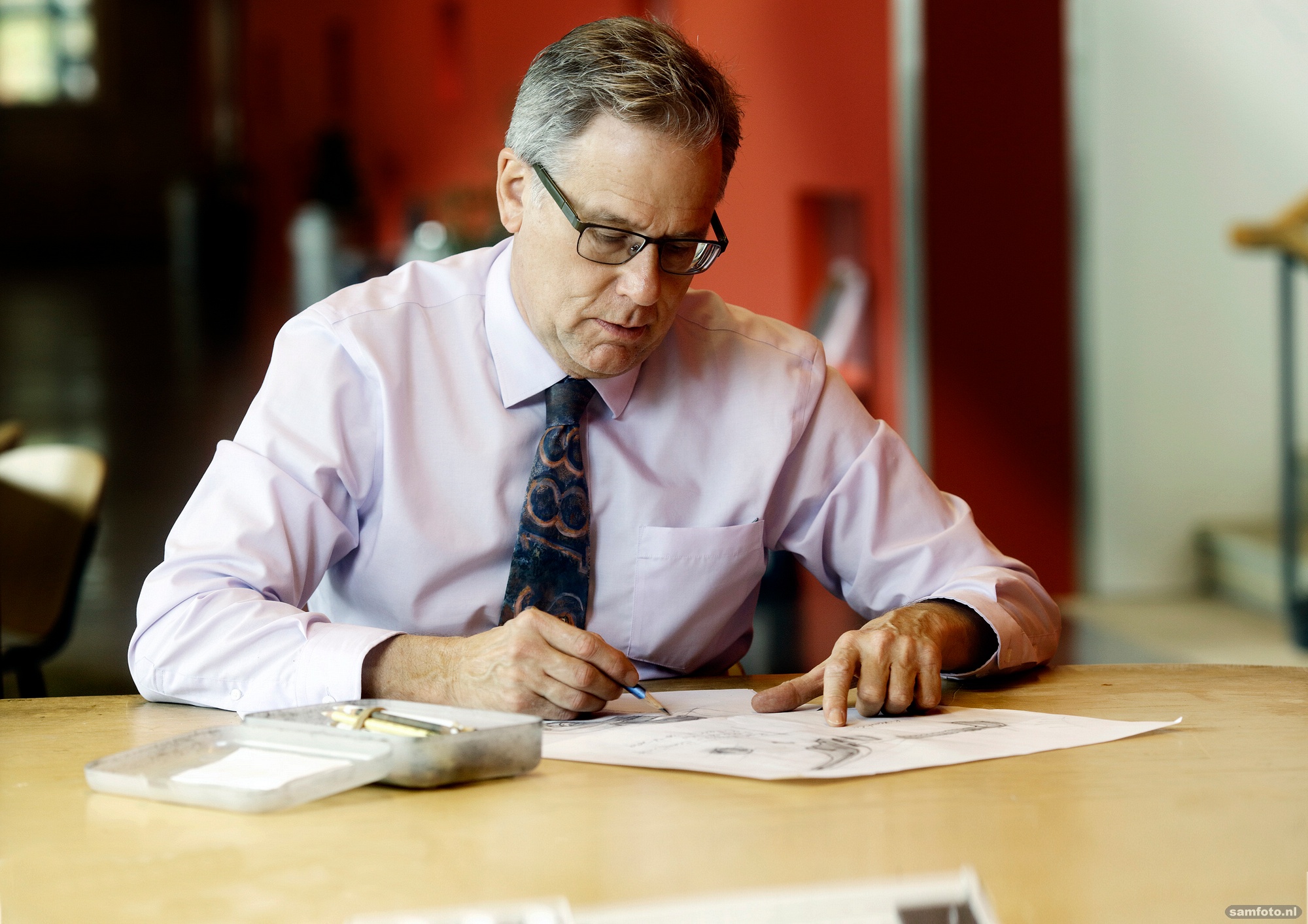Anyone can learn how to freehand sketch, so 44 3mE master students learned the last eight weeks. In this interview, their American professor shares his secret.
Richard Marklin: "When students say ‘I can’t draw’, my answer is: ‘You have never been taught. Just use the method’." (Photo: Sam Rentmeester)
Freehand sketching can be useful to engineering students, yet learning this skill is rarely part of their curriculum. In fact, mechanical engineering students at the 3mE Faculty have not had the opportunity to practice their drawing skills, apart from a limited first year’s sketching course. So, American professor Richard Marklin was welcomed with open arms when he suggested spending his sabbatical at TU Delft to host a freehand sketching master’s course. The results are impressive, even to the students themselves. Delta interviewed Marklin, right before the students hung their drawings in the 3mE hallway for a short exhibition on Wednesday morning 6 November.
How did you end up at TU Delft?
“I wanted to spend my second sabbatical abroad and TU Delft has a very good reputation. A 2017 MIT report rated TU Delft as a top 10 institution of ‘current leaders’. Also, my wife has more than 30 relatives in the Netherlands. Her grandfather emigrated to the US in 1913. The families always kept in touch, so she really wanted to go. I didn’t know anybody at TU Delft, though. I wrote an email with my proposal for a freehand sketching course to the 3mE Dean, to Professor Heike Vallery and to two others. Heike responded within 24 hours and within a week we had a Skype call. The first question was: ‘how are you going to sustain the course after you leave?’.”
‘I never mention art, because we’re not doing art’
So everyone agreed you had a good idea. When did you start freehand sketching at your own university, Marquette University?
“I always had an interest in drawing for applied purposes, to visually communicate ideas. I started working at Marquette in 1991. We still had large drawing tables back then, but they threw them away. That was a mistake. Leaders in industry told us ‘your students can’t sketch or draw’. I said: ‘of course they can’t. We don’t teach them.’ In 2006, we brought the drawing tables back. In 2012, I taught a short hand sketching course to the engineering students for the first time, after previously starting with high school students.”
Over the last two months Marklin has taught 44 3mE students to freehand sketch. While pinning their final project sketches to exhibition boards in the Faculty hallway they all tell the same story. “If you had told me eight weeks ago that I drew these sketches I wouldn’t have believed you”, one of them said, his sketches showing a detailed Go Pro camera from different angles. “I didn’t have any experience with sketching before this.”
So, how does Marklin do it, what is his secret? As he stresses several times during the interview no artistic talent or sketching experience is needed. “I never mention art, because we’re not doing art. That word just puts up a roadblock. Our drawings are based on squares and cubes,” Marklin explained, while drawing three squares and within that frame a sketch of a 2D men’s shoe, followed by a series of three cubes containing a 3D sketch of the same shoe.
You did that in seconds. Anyone with no drawing experience will say: ‘I could never do that’.
“Maybe not this fast. I have been drawing for 58 years. But when students say ‘I can’t draw’, my answer is: ‘You have never been taught. Just use the method’. I teach freehand sketching like a TV cookery show, and now, with help of the fantastic TU Delft Teaching Lab, I even have my own YouTube videos. An important part of my method is the focus on proportions, not on scale. Students who have had some sketching experience mostly learned to sketch using measuring tools. I don’t use any tools. I just need a pencil and a steady surface.”
Continue reading under the video.
You think all engineers should learn to freehand sketch again. Why?
“My short term goal is to teach students to visually communicate an idea, only with a pencil and nothing else. The long term goal is to improve creativity and innovation of new designs. It helps the creative process, because its speed makes it effective. Engineers who can sketch, will have a greater influence on a design; they command the white board. CAD (a designing software commonly used in universities around the world, ed.) is effective as well, but at a later design stage, when you’re working out the details. With CAD you can only draw one or two ideas, while you can sketch twenty by hand. Freehand sketching is just faster.”
But if speed is the only benefit, I could argue that you could just take more time sketching ideas in CAD.
“The problem with CAD that it looks too good in the early stages of a design process. That makes people resistant to change their idea, even if others see right away that it won’t work. Hand sketches are not that refined. We are trying to bring back this old tradition.”
So, as you were asked in your very first Skype call with TU Delft, how are you going to sustain the course after you leave?
“I would like to bring freehand sketching back to mechanical engineering curricula. No one else is doing this, because they can’t draw themselves. I therefore need to train the trainers. We can use the videos as teaching material. I would like to come back to TU Delft to teach for shorter periods of time and use our experience here as a beachhead for spreading the course throughout Europe. I’ll retire in two years, but I can continue doing this after retirement.”
- Visit Richard Marklin’s Youtube channel here.



Comments are closed.